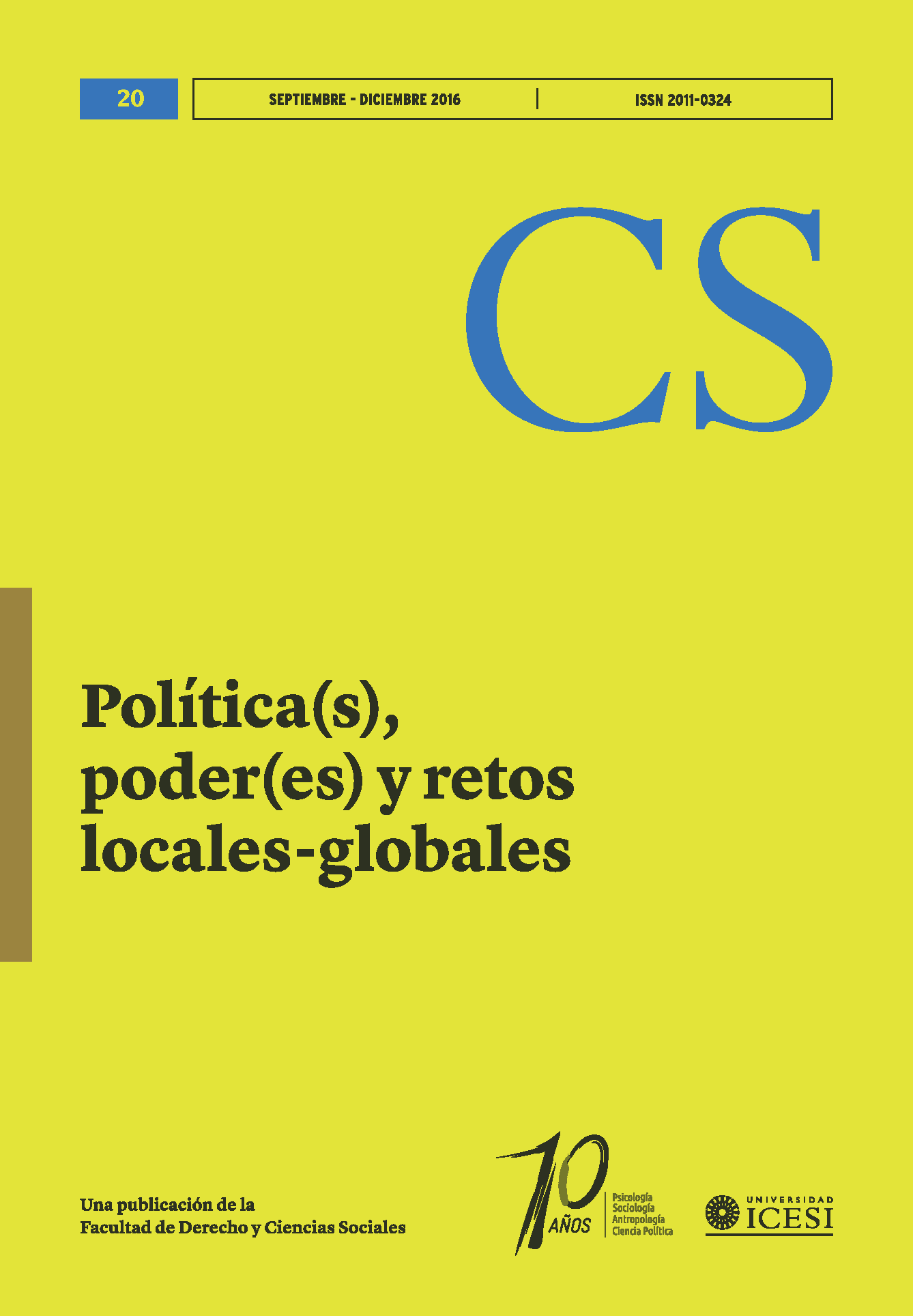Vulnerabilidad y prácticas de información: experiencias de migrantes latinos (indocumentados) en EE.UU.
DOI:
https://doi.org/10.18046/recs.i20.2211Palabras clave:
Migrantes latinos, Indocumentados, prácticas de información, Comportamientos de información, Fotografía participativaResumen
Este artículo explora las prácticas de información (búsqueda, uso y distribución de la información) de los migrantes latinos, en particular de aquellos que están indocumentados en la frontera entre México y EE. UU, y en Seattle, Washington. En estos contextos se generan prácticas de información diferentes. En la frontera encontramos más prácticas de pobreza de información tipo “pequeño mundo”, las cuales se van ampliando y consolidando a medida que se fortalece el sentido de pertenencia después de pasar más tiempo establecidos en EE. UU. Sin embargo, la vulnerabilidad y la transitoriedad se mantienen, ante el riesgo permanente de deportación. Los hallazgos del estudio en comunidades colombianas se presentan en otro artículo complementario, en este mismo volumen. A través de la fotografía participativa y entrevistas no estructuradas, exploramos las vivencias y las prácticas de información de comunidades marginadas, y las relacionamos con cómo vivencian la transitoriedad a lo largo de las distintas etapas de la experiencia migratoria. También discutimos cómo las etapas de la migración pueden no ser suficientes para dar cuenta de los constantes cambios e iteraciones en las experiencias de los migrantes que estudiamos.
Descargas
Referencias
Baron, L. F., Neils, M., & Gomez, R. (2013). Crossing new borders: computers, mobile phones, transportation and English language among Hispanic day laborers in Seattle. Journal of the American Society for Information Science and Technology (JASIST), 64(5).
Blakeley, K. (2015, September 27). Mark Zuckerberg wants to bring Facebook to migrants. Daily Mail.
Bronsam, G. (n.d.). Norway is using Facebook to send a stark message to migrants. BBC News. Retrieved from http://www.bbc.com/news/magazine-34813650
Caidi, N., Allard, D., & Quirke, L. (2010). Information practices of immigrants. Annual Review of Information Science and Technology, 44(1), 491–531.
Carter, M., & Grover, V. (2015). Me, My Self, and I (T): Conceptualizing Information Technology Identity and its Implications. MIS Quarterly, 39(4).
Chatman, E. A. (1996). The Impoverished Life-World of Outsiders. Journal of the American Society for Information Science, 47, 193–206.
Chatman, E. A. (1999). A theory of life in the round. Journal of the Association for Information Science and Technology, 50(3), 207.
Chatman, E. A., & Pendleton, V. E. (1995). Knowledge gap, information-seeking and the poor. The Reference Librarian, 23(49-50), 135–145.
Chomsky, A. (2014). Undocumented: how immigration became illegal. Beacon Press.
COHA. (n.d.). Young Voices From the Border: Fear and Unaccompanied Migrant Children. Retrieved from http://www.coha.org/young-voices-from-the-border-fear-and-unaccompanied-migrant-children/
Cunningham, E. (2015, September 16). Facebook is the new travel guide for Iraqis headed to Europe - The Washington Post. The Washington Post. Retrieved from http://wpo.st/YUAb0
Ensor, J. (2015, September 20). The Facebook group helping migrants reach Europe. The Telegraph. Retrieved from http://www.telegraph.co.uk/news/worldnews/europe/croatia/11877508/The-Facebook-group-helping-migrants-reach-Europe.html
Fisher, K., Marcoux, E., Miller, L., Sanchez, A., & Ramirez Cunningham, E. (2004). Information Behavior of Migrant Hispanic Farm Workers and their Families in the Pacific Northwest. Information Research, 10. Retrieved from http://informationr.net/ir/10-1/paper199.html
Gomez, R., & Vannini, S. (2015). Fotohistorias: Participatory Photography and the Experience of Migration. Charleston, SC: CreateSpace.
Gonzalez-Barrera, A., & Krogstad, J. M. (2014, October 2). U.S. deportations of immigrants reach record high in 2013. Retrieved June 8, 2015, from http://www.pewresearch.org/fact-tank/2014/10/02/u-s-deportations-of-immigrants-reach-record-high-in-2013/
ITEP. (2013). Undocumented Immigrants’ State and Local Tax Contributions. Washington DC, USA: Institute of Taxation and Economic Policy. Retrieved from http://www.itep.org/pdf/undocumentedtaxes.pdf
Izcara Palacios, S. P. (2012). Violencia contra inmigrantes en Tamaulipas. European Review of Latin American and Caribbean Studies, 93, 3–24.
Izcara Palacios, S. P. (2016). Los Transmigrantes Centroamericanos En México. Latin American Research Review, 50(4), 49–68. https://doi.org/10.1353/lar.2015.0050
Izcara Palacios, S. P. (2016). Violencia postestructural: migrantes centroamericanos y cárteles de la droga en México. Revista de Estudios Sociales, (56), 12–25.
Izcara Palacios, S. P., & Andrade Rubio, K. L. (2015). Causas e impactos de la deportación de migrantes centroamericanos de Estados Unidos a México. Estudios Fronterizos, 16(31), 239–271.
Jensen, B. (2002). Service to day laborers: a job libraries have left undone. Ref User Serv Q Reference & User Services Quarterly, 41, 228–33.
Nail, T. (2015). The Figure of the Migrant. Stanford, California: Stanford University Press.
Newell, B. C., & Gomez, R. (2014). Informal Networks, Phones and Facebook: Information Seeking and Technology Use by Undocumented Migrants at the U.S.-Mexico Border. Proceedings of iConference 2015, Rochester, NY. Retrieved from http://papers.ssrn.com/abstract=2539396
Newell, B., Gomez, R., & Guajardo, V. (2016). Information seeking, technology use, and vulnerability among migrants at the US-Mexico border. The Information Society. Retrieved from http://www.narcis.nl/publication/RecordID/oai:tilburguniversity.edu:publications%2F0fa2fd3c-2b33-45eb-be12-69f248c53ceb
Passel, J. S., & Cohn, D. (2011). Unauthorized Immigrant Population: National and State Trends, 2010 (Pew Research Center). Pew Hispanic Center. Retrieved from http://pewhispanic.org/files/reports/133.pdf#page=25
Perryman Group. (2008). An Analysis of the Economic Impact of Undocumented Workers on Business Activity in the US with Estimated Effects by State and by Industry. Waco, Texas, USA. Retrieved from http://www.ilw.com/articles/2008,1008-perryman.pdf
Reuters. (2014, July 5). Migrantes y “polleros” utilizan Facebook para acordar el cruce de frontera. La Jornada. Mexico. Retrieved from http://www.jornada.unam.mx/ultimas/2014/08/05/migrantes-y-polleros-utilizan-redes-sociales-para-organizar-paso-por-la-frontera-7977.html
Savolainen, R. (2008). Everyday information practices: a social phenomenological perspective. Scarecrow Press.
Schiller, N. G., Basch, L., & Blanc, C. S. (1995). From immigrant to transmigrant: Theorizing transnational migration. Anthropological Quarterly, 48–63.
Vannini, S., Gomez, R., & Guajardo, V. (2016). Security and Activism: Using participatory photography to elicit perceptions of Information and Authority among Hispanic migrants in the U.S. In Proceedings of iConference 2016. Philadelphia, PA.
Yefimova, K., Neils, M., Newell, B. C., & Gomez, R. (2015). Fotohistorias: Participatory Photography as a Methodology to Elicit the Life Experiences of Migrants. In Proceedings of HICSS 48. Hawaii. Retrieved from http://papers.ssrn.com/abstract=2482520
Publicado
Número
Sección
Licencia
Derechos de autor 2016 Ricardo Gómez

Esta obra está bajo una licencia internacional Creative Commons Atribución-NoComercial 4.0.
© Derechos reservados de autor
El material de esta publicación puede ser reproducido sin autorización, siempre y cuando se cite el título, el autor y la fuente institucional.
El contenido publicado en Revista CS se distribuye bajo la licencia Creative Commons BY-NC 4.0 Atribución/Reconocimiento-NoComercial 4.0 Internacional.
Usted es libre de:
Compartir — copiar y redistribuir el material en cualquier medio o formato.
Adaptar — remezclar, transformar y construir a partir del material.
Bajo los siguientes términos:
Atribución — Usted debe dar crédito de manera adecuada, brindar un enlace a la licencia, e indicar si se han realizado cambios. Puede hacerlo en cualquier forma razonable, pero no de forma tal que sugiera que usted o su uso tienen el apoyo de la licenciante.
NoComercial — Usted no puede hacer uso del material con propósitos comerciales.












